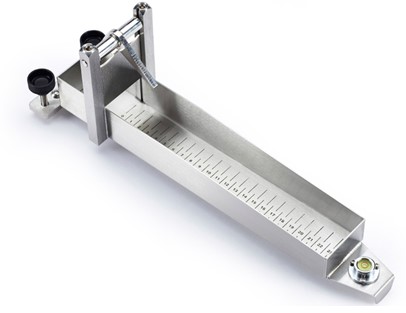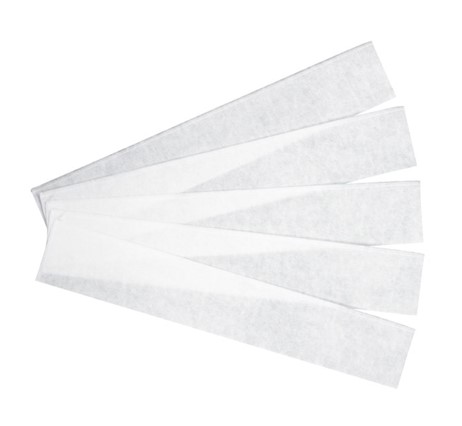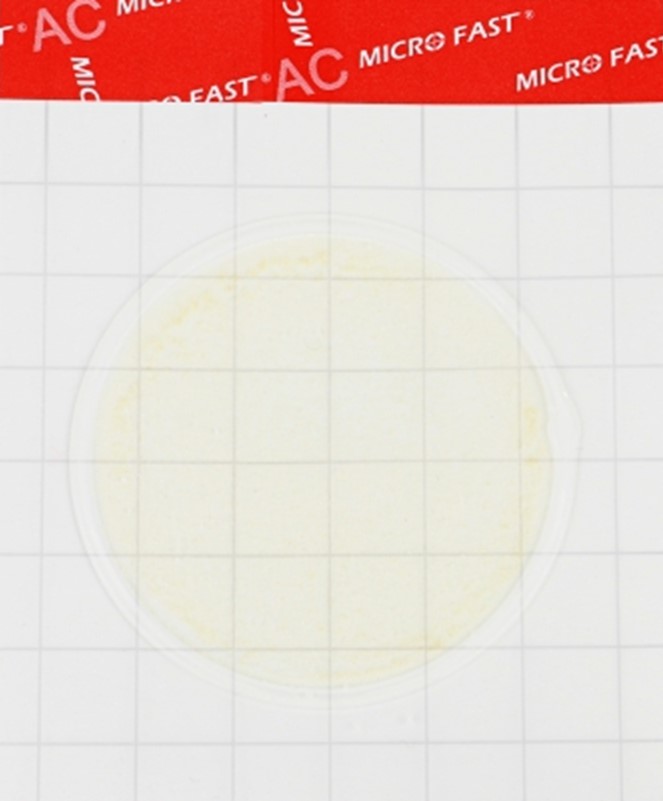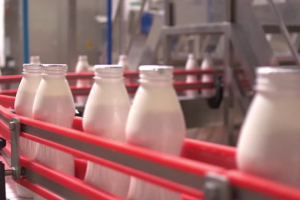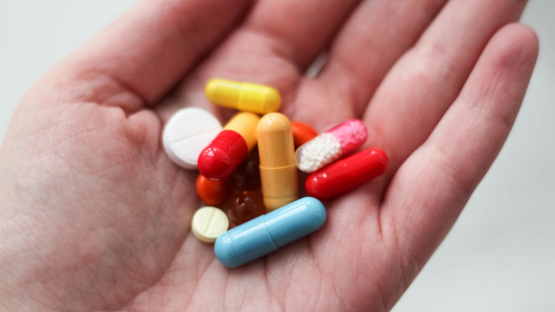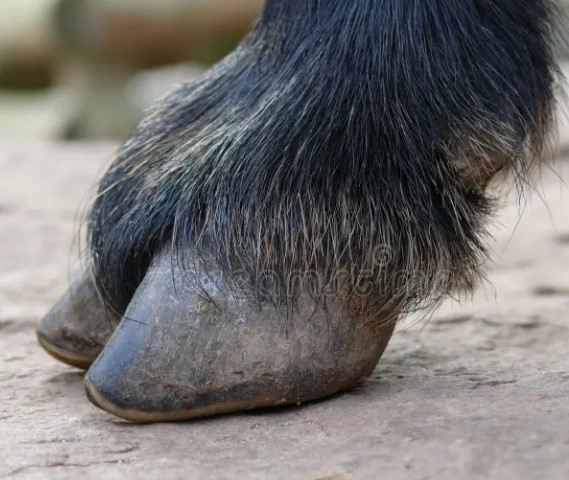TEST KIT for determination of inhibitory agents PIONEERPRODUKT® DASH-TEST, WC0040

Test - set PIONEERPRODUKT® DASH - TEST
Article No. WC 0040
Introduction
PIONEERPRODUKT® DASH-TEST test kit is a microbiological test for the qualitative detection of residual quantities of antibiotics and inhibitory substances in raw (cow, goat, sheep), pasteurized, sterilized and pre-reconstituted MILK powder .

Principle
The PIONEERPRODUKT® DASH-TEST test kit is based on a microbiological inhibition method. The wells contain medium with B acillus stearothermophilus spores and a pH indicator. During cultivation at 65°C, spores germinate, bacterial growth occurs and the environment becomes acidified. The pH value decreases and the indicator changes from the original purple color to yellow. If a sample of milk and dairy products contains antibiotics or other inhibitory substances, they will inhibit the growth of bacteria, thereby no acid will be produced, the indicator will not change color and will remain the original purple color. If antibiotics or other inhibitory substances are present in milk and dairy products or their concentration is below the detection limit, spores germinate, bacterial growth occurs, acid is produced and the medium turns yellow.
Storage conditions
1. Storage temperature: 2-8 °C
2. Shelf life: 18 months from the date of production
Supplied reagents and materials
|
Tear-off block with microholes |
1 block (96 individual tests per block) |
|
Protective film (aluminum foil) |
1 |
|
Instructions |
1 |
|
Colorimetric map |
1 |
|
Negative control ( milk without antibiotics) |
1 |
|
Positive control (milk containing 4 mg/l Penicillin G or 4 mg/l ampicillin) |
1 |
|
Dispenser (single-channel micropipette) 100 µl |
1 |
|
Tips |
100 |
Additional required materials that are not included in the kit
- Heating equipment with a stable temperature regime of 65 °C (water bath or dry heating block (thermostat-incubator))
Preparation of negative and positive control samples to monitor the accuracy of the kit
Add 500 µl of deionized or distilled water to the negative and positive control vials and mix vigorously until the contents of the vials are completely dissolved. Control samples are ready for use.
Attention: control samples must be prepared immediately before use.
Analysis procedure
1. Carefully remove the required number of microwells without damaging the protective film on the remaining wells. Microwells should be kept at room temperature for 15 minutes. Seal the remaining ingredients immediately. The components must be stored at a temperature of 2-8 °C.
2.Remove the protective film on the microwells, add 100 µl of the test sample to each well (Caution: do not mix the contents by pipetting). To control the accuracy of the kit, negative and positive control samples are introduced in parallel.
3. Cover the microwells with a protective film (aluminum foil), place them vertically in a water bath or in an incubator at a temperature of 65°C and incubate at a temperature of (65±2)°C for approximately 2 hours to 2 hours 45 minutes (when the negative control turns yellow).
Note: If sensitivity needs to be determined, a negative control can be used to determine the exact culture time. Procedure: incubate for 2 hours, then start monitoring the color of the negative control. it is recommended to monitor every 5 minutes. When the negative control turns yellow, immediately read the results of all remaining samples.
4. After completion of the reaction, the microwells are removed from the water bath or thermostat, the color of their contents is determined and the result is obtained:
- negative result : the color of the medium is bright yellow or yellow
- positive result: the color of the medium is purple
Detection Limit Results: If the color of the medium is between yellow and purple or the color does not change (remains purple), this means that the concentration of the antibiotic or inhibitory substance is within the detection limit of the kit and the result should be considered positive.
Interpretation of results

Bright yellow Yellow-violet Violet
Negative (-) Detection limit (+) Position (++)
Precautionary measures
1. It is recommended to use milk without antibiotic as a negative control and milk containing a high concentration of antibiotics as a positive control to monitor the accuracy of the kit.
2. This product is a tear-off microwell plate. Take the required number of microwells by first cutting off the protective film (aluminum foil) with a knife along the demarcation line, carefully without damaging the film on the remaining wells to avoid contamination and cracks in the nutrient medium. Seal the remaining ingredients immediately. The components must be stored at a temperature of 2-8 °C.
3. This product cannot directly detect acidic substances, such asyogurt .
4. This kit is sensitive to antibiotics and other bacteriostatic (inhibitory) substances (eg detergents, disinfectants, preservatives). When conducting the experiment, avoid contamination with these substances. It is necessary to wash and dry your hands thoroughly before testing, and conduct testing on a clean surface.
5. Do not shake the microplate vigorously to avoid shaking the solid medium, otherwise it will affect the final color.
6. Store the microplate in an upright position in a dark place and at a constant temperature, preferably at a temperature of 2-8 ° C. Do not freeze. Temperature fluctuations can soften and loosen the medium. Too high a temperature will shorten the shelf life.
7. The incubation temperature of the medium should be strictly controlled at 65+2°C, if the temperature is too high or too low, or there is temperature fluctuation, it will affect the reaction time and detection sensitivity.
8. With this test, different types of dairy products are tested for different amounts of time (from 2 hours to 2 hours 45 minutes).
9. As the storage period increases, the required cultivation time can be gradually increased. For reagents that are already expiring, the inhibition time should be increased and should be longer than for freshly produced kits, so it is recommended that when using such a kit, the incubation time should be related to the point at which the negative control turns yellow.
10. The used microplate can be disposed of after it has been sterilized, for example by high pressure.
Sensitivity
See Appendix 1 for information on detection limits and mass fraction.
The method using the pioneer PRODUKT ® DASH-TEST test kit is included in GOST 31502-2012 “ Milk and dairy products. Microbiological methods for determining the presence of antibiotics" (from Amendment No. 1, clause 5.3.1) and in GOST 23454-2016 "Milk. Methods for determining inhibitory substances" (clause 9).
Annex 1
Sensitivity
|
Antibiotic |
EU limit |
Detection limit (µg/l) |
|
Beta lactams |
||
|
Penicillin G(Benzylpenicillin) |
4 |
2 |
|
4 |
2 |
|
|
4 |
2 |
|
|
thirty |
10 |
|
|
thirty |
20 |
|
|
thirty |
6-10 |
|
|
thirty |
10 |
|
|
Cefacetril |
125 |
20 |
|
100 |
60-80 |
|
|
Cephalonium |
20 |
10 |
|
50 |
25 |
|
|
Ceftiofur |
100 |
50 |
|
20 |
75 |
|
|
Cefapirin |
60 |
2.5-4 |
|
Cefazolin |
50 |
10 |
|
50 |
thirty |
|
|
Tetracyclines |
||
|
100 |
100 |
|
|
Doxycycline |
|
100 |
|
Oxytetracycline |
100 |
100 |
|
100 |
100 |
|
|
Sulfonamides |
||
|
Common sulfonamides/ 100 |
25-50 |
|
|
25-50 |
||
|
100 |
||
|
Sulfathiazole |
20 |
|
|
50 |
||
|
50 |
||
|
<25 |
||
|
60-80 |
||
|
Sulfisoxazole |
50 |
|
|
Sulfaclorpyridazine |
25-50 |
|
|
Sulfafenazole |
25-50 |
|
|
50 |
||
|
100 |
||
|
Sulfaclozin |
100 |
|
|
Sulfapyrazole |
50 |
|
|
Sulfamethoxypyrazine |
25-50 |
|
|
Sulfizomidine |
50 |
|
|
50 |
||
|
Sulfapyridine |
100 |
|
|
50 |
||
|
Sulfamethazole |
100 |
|
|
Sulfamethizole |
80-100 |
|
|
Macrolides |
||
|
40 |
40 |
|
|
200 |
400 |
|
|
Tilmcozin |
50 |
50 |
|
Tylosin |
50 |
20-25 |
|
Quinolones |
||
|
Ciprofloxacin |
100 |
1000-1500 |
|
Danofloxacin |
thirty |
1000-2000 |
|
75 |
1000 |
|
|
100 |
100 |
|
|
150 |
2500 |
|
|
1500 |
200-300 |
|
|
200 |
>300 |
|
|
200 |
600 |
|
|
Dihydrostreptomycin |
200 |
700-1000 |
|
Rest |
||
|
|
2500 |
|
|
Rifaximin |
60 |
60-100 |
|
100 |
50 |
|
|
50 |
1000 |
|
|
50 |
100 |
|
|
150 |
150 |
|
This drug is not intended for use in animals whose milk is produced for human consumption.
This drug is prohibited.
Sensitivity
|
Inhibitory substance |
Mass fraction (%) |
|
Active chlorine |
0.12 |
|
Hydrogen peroxide |
0.02 |
|
Peracetic acid |
0.01 |
|
Sulfonol |
0.12 |
|
Formalin |
0.003 |
Manufacturer:
Beijing Meizheng Bio-Tech Co., No.-2 Building, No.-8 Courtyard, Fenggusilu Road, Yanqing District, (Zhongguancun Yanqing Science Park), Beijing; CHINA .
Read together with it:
- Трамп пригрозил России жесткими санкциямиТрамп заявил, что у него «заканчивается терпение» в отношении Путина из-за затягивания урегулирования конфликта на Украине, и пригрозил жесткими санкциями, например, против банков и нефти. Москва считает санкции незаконными 00:00 Реклама 00:00 00:00 / 00:00 720p 576p480p360p224p Пропустить рекламу можно через Подробнее Video Президент США Дональд Трамп в эфире Fox News пригрозил «очень жестко удар...
- США призвали ЕС и G7 к пошлинам против Китая и Индии из-за нефти РоссииСША призвали Евросоюз и страны G7 ввести пошлины 50–100% для Китая и Индии, чтобы они прекратили закупать российскую нефть. BLOOMBERG пишет, что Вашингтон также обсуждает с ЕС изъятие российских заблокированных активов США призвали Евросоюз и членов «Большой семерки» ввести «значимые тарифы» на импорт из Китая и Индии, чтобы они прекратили закупать российскую нефть, а также созвали экстренное фина...
- ЕС продлил санкции против России, но сделал два исключенияЕС уберет из санкционного списка одно физлицо и одного умершего человека. Кто они — пока не раскрывается. В остальном санкции продлены еще на полгода Совет ЕС продлил введенные после начала военной операции на Украине персональные санкции против россиян на полгода, до 15 марта следующего года, говорится в сообщении на его сайте. «В рамках пересмотра санкций Совет также принял решение не продлевать...
- В ФРГ начали расследование против немца из-за посылки с мылом из РоссииПрокуратура города Шверин в федеральной земле Мекленбург — Передняя Померания в Германии начала расследование против немецкого фермера, получившего в подарок из России посылку с мылом, деревянной фигуркой и CD-диском. Его подозревают в нарушении санкционного режима ЕС против России, сообщила телерадиокомпания NDR. Стоимость всей посылки оценивается в ₽2,5 тыс., или в €26,83. Это был подарок на Пас...
- Экспорт белорусского продовольствия в I полугодии вырос на 13%12 сентября, Минск. Экспорт белорусских продовольственных товаров и сельскохозяйственного сырья в I полугодии текущего года вырос на 13%, сообщили БЕЛТА в пресс-службе Минсельхозпрода."Наши основные экспортные позиции - мясная и молочная продукция, продукция растениеводства. Уверенный рост достигается в том числе проводимым Минсельхозпродом мониторингом цен на отдельные виды продовольственной прод...
- Китайские пошлины угрожают европейскому сектору свининыЕвропейский свиноводческий сектор и вся цепочка создания стоимости, связанная с производством свинины, глубоко обеспокоены результатами антидемпингового расследования, проведенного китайскими властями в прошлом году, а также временными мерами, введенными в отношении нашей отрасли. Пока ещё слишком рано оценивать все экономические последствия, но они будут ощущаться по всему Союзу . Наибольшее давл...
- В Европе оценили готовность Трампа оказать давление на РоссиюЕвропейские лидеры полагают, что Трамп наконец-то занял их сторону и готов оказать давление на Россию. Однако подходы у сторон разные: Вашингтон предпочитает пошлины, Брюссель — санкции, отмечает Politico Дональд Трамп Коалиции европейских лидеров удалось убедить президента США Дональда Трампа, что Россия «не заинтересована» в прекращении боевых действий на Украине и ее следует заставить сесть за ...
- DPA узнало о плане Германии по ужесточению выдачи Шенгена россиянамГермания хочет добиться ужесточения визового режима для россиян в рамках нового санкционного пакета, пишет DPA. В подготовленном Берлином документе содержится требование к Еврокомиссии полностью реализовать рекомендации 2022 года В рамках нового пакета санкций Евросоюза правительство Германии намерено добиться ограничений на выдачу виз гражданам России для поездок в страны Шенгенской зоны, сообщае...
- Каллас заявила о продлении санкций ЕС против РоссииКая Каллас Евросоюз принял решение о продлении антироссийских санкций, заявила в соцсети Х верховный представитель ЕС по иностранным делам и политике безопасности Кая Каллас. «Мы только что продлили наши санкции против России», — написала она. По словам Каллас, Евросоюз также завершил работу над 19-м санкционным пакетом. В его рамках были рассмотрены дополнительные ограничения на продажу российско...
- Лукашенко — о снятии санкций США с «Белавиа»: «Спасибо им за это»Александр Лукашенко Президент Белоруссии Александр Лукашенко поблагодарил США за снятие некоторых санкций с Белоруссии, передает БелТА. «То, что они начали снимать санкции с нас — американцы, — спасибо им за это, нам будет легче работать. Это тоже очень важно», — отметил глава государства на встрече с постпредом Белоруссии при ООН Валентином Рыбаковым. ......








